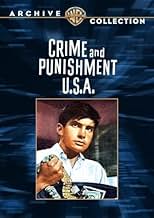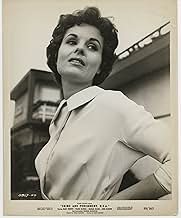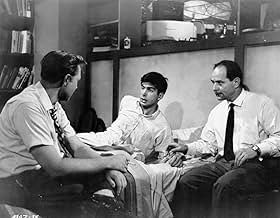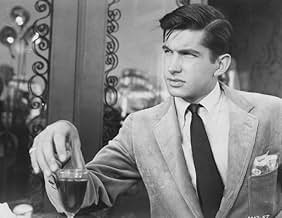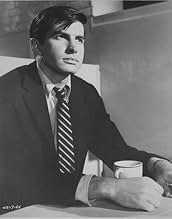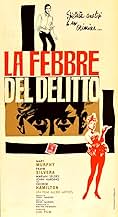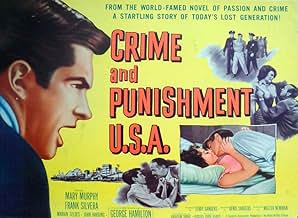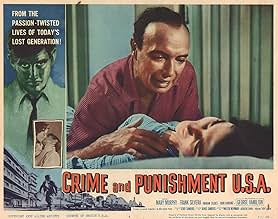Füge eine Handlung in deiner Sprache hinzuA Californian law student murders a pawnbroker, then matches wits with the detective on the case.A Californian law student murders a pawnbroker, then matches wits with the detective on the case.A Californian law student murders a pawnbroker, then matches wits with the detective on the case.
- Regie
- Drehbuch
- Hauptbesetzung
- Nominiert für 1 BAFTA Award
- 2 Gewinne & 1 Nominierung insgesamt
Tony Johnson
- Mrs. Cole
- (as Toni Merrill)
Sidney Clute
- Doctor
- (as Sid Clute)
James Hyland
- Man in Coffee Shop
- (as Jim Hyland)
Empfohlene Bewertungen
I haven't seen this movie for more years than I care to remember. It was released accompanied by sensationalistic contemporary tag lines -- "Beatniks! Rebels!" -- partly because George Hamilton is seen playing the bongos once in a while. Yet, it has stuck in my memory. It really was an unusual film.
First of all, Dostoyevsky is rather awkwardly superimposed on a story involving residents of modern L.A. The novel doesn't quite fit on the setting. People have serious conversations about God and the afterlife. Okay for a 19th-cntury Rusian novel -- but sunny California? Home of the Fountain of the World Cult?
And it always bothered me about the novel that everyone in Petersberg seems to be acquainted with everyone else. It was a bit difficult to swallow that proposition in the novel; it is absolutely impossible for that to have been true in L.A. circa 1960, the most anomic community on the face of the planet. But instead of being an irritation, the lack of fit between the plot and its contemporary setting lends the film an unquiet, almost surreal quality. Something is off kilter and we don't know exactly what. We squirm with bemusement.
Two points ought to be made. The movie must have been shot on the cheap. In this case, it inadvertently helps. We are given a tour of the seedier sections of L.A. -- railroad tracks, refuse dumps, shabby housing -- that a better-funded film would probably have avoided. Instead of Echo Park we get a slum. This is commonplace now, but it wasn't at the time. It's too bad nobody in California seems to know what a genuine slum looks like. Here it's all a sun-drenched, palm-fronded, flower-strewn paradise, however desecrated. They should have set it in Newark. And they needn't have used high-key lighting so consistently. It looks like an early television sitcom.
Second, the acting is actually quite good. I am even willing to forgive George Hamilton's handsomeness. (He's always been willing to poke fun at himself anyway.) Mary Murphy is not the young naif she played in "The Wild One." She's not exactly a hooker either, as she was in the novel. In 1960 neither audiences nor agents of social control were prepared for that. But she is a serious kind of easy lay, which was still saying a lot. Best of all is Frank Silvera. The smooth admirable way in which he insinuates himself into Robert's life. The cat and mouse repartee. The wondering expression on his face, his amazement that Hamilton has not yet caught on, as he tells him who committed the murder -- "Why YOU did, Robert."
I don't know how I would respond to the movie now, lo, these many years later. But, crude as it is, it's not just a shoddy ripoff of a famous psychological drama. It would be a mistake to think so. If all the elements of the film are amateurish, as in a high school play, the people involved seem to be hitting the right notes by accident. This is worth catching, a real curiosity.
First of all, Dostoyevsky is rather awkwardly superimposed on a story involving residents of modern L.A. The novel doesn't quite fit on the setting. People have serious conversations about God and the afterlife. Okay for a 19th-cntury Rusian novel -- but sunny California? Home of the Fountain of the World Cult?
And it always bothered me about the novel that everyone in Petersberg seems to be acquainted with everyone else. It was a bit difficult to swallow that proposition in the novel; it is absolutely impossible for that to have been true in L.A. circa 1960, the most anomic community on the face of the planet. But instead of being an irritation, the lack of fit between the plot and its contemporary setting lends the film an unquiet, almost surreal quality. Something is off kilter and we don't know exactly what. We squirm with bemusement.
Two points ought to be made. The movie must have been shot on the cheap. In this case, it inadvertently helps. We are given a tour of the seedier sections of L.A. -- railroad tracks, refuse dumps, shabby housing -- that a better-funded film would probably have avoided. Instead of Echo Park we get a slum. This is commonplace now, but it wasn't at the time. It's too bad nobody in California seems to know what a genuine slum looks like. Here it's all a sun-drenched, palm-fronded, flower-strewn paradise, however desecrated. They should have set it in Newark. And they needn't have used high-key lighting so consistently. It looks like an early television sitcom.
Second, the acting is actually quite good. I am even willing to forgive George Hamilton's handsomeness. (He's always been willing to poke fun at himself anyway.) Mary Murphy is not the young naif she played in "The Wild One." She's not exactly a hooker either, as she was in the novel. In 1960 neither audiences nor agents of social control were prepared for that. But she is a serious kind of easy lay, which was still saying a lot. Best of all is Frank Silvera. The smooth admirable way in which he insinuates himself into Robert's life. The cat and mouse repartee. The wondering expression on his face, his amazement that Hamilton has not yet caught on, as he tells him who committed the murder -- "Why YOU did, Robert."
I don't know how I would respond to the movie now, lo, these many years later. But, crude as it is, it's not just a shoddy ripoff of a famous psychological drama. It would be a mistake to think so. If all the elements of the film are amateurish, as in a high school play, the people involved seem to be hitting the right notes by accident. This is worth catching, a real curiosity.
A young man murders an old woman for money, then relies on a sense of intellectual superiority to defeat an investigating detective.
A heavyweight subject like Dostoevski would be a challenge for the most experienced filmmaker. For the youthful crew here, however, it proves way too much. For one, Hamilton simply doesn't have the gravitas to bring off a convincing intellectual heavyweight, and that punches a hole right through the film's middle. But he's not the only one. Silvera's cagey detective makes those cat and mouse sessions with Robert (Hamilton) borderline parody. I don't know what director Sanders was telling him, but whatever it was, it didn't work. Ditto Harding's hammy wife killer that produces another regrettable result. Unfortunately, acting here means more than usual since there's so much loaded conversation. Only the two women, Murphy and Seldes, come off aptly.
On the other hand, the filmmakers certainly don't lack imagination. Adapting a bleak 19th- century Russian novel to the sunny climes of LA amounts to an imaginative undertaking, whatever the outcome. However, modifying a dense 1,000-page novel into a 70-minute screenplay would be a challenge for Dostoevski himself. Unfortunately, the effort here is like trying to pack 10 lbs. of weighty story into a 5 lb. leaky screenplay. All in all, I'm glad the Sanders brothers and Hamilton went on to more appropriate projects.
A heavyweight subject like Dostoevski would be a challenge for the most experienced filmmaker. For the youthful crew here, however, it proves way too much. For one, Hamilton simply doesn't have the gravitas to bring off a convincing intellectual heavyweight, and that punches a hole right through the film's middle. But he's not the only one. Silvera's cagey detective makes those cat and mouse sessions with Robert (Hamilton) borderline parody. I don't know what director Sanders was telling him, but whatever it was, it didn't work. Ditto Harding's hammy wife killer that produces another regrettable result. Unfortunately, acting here means more than usual since there's so much loaded conversation. Only the two women, Murphy and Seldes, come off aptly.
On the other hand, the filmmakers certainly don't lack imagination. Adapting a bleak 19th- century Russian novel to the sunny climes of LA amounts to an imaginative undertaking, whatever the outcome. However, modifying a dense 1,000-page novel into a 70-minute screenplay would be a challenge for Dostoevski himself. Unfortunately, the effort here is like trying to pack 10 lbs. of weighty story into a 5 lb. leaky screenplay. All in all, I'm glad the Sanders brothers and Hamilton went on to more appropriate projects.
"Crime & Punishment, USA" updates Fyodor Dostoevsky novel to the 20th century and transports it from Saint Petersburg to Los Angeles. It wasn't the first film to do so, with a 1956 French adaptation and, before that, the American "Fear" (1946) is a "Crime and Punishment" picture in all but name; plus, another 1959 reworking also from France, Robert Bresson's "Pickpocket," took even more liberties with the text that it's, nonetheless, clearly inspired by. I'm not opposed to loose reworkings in the transmutation from prose to picture; indeed, "Pickpocket" is my favorite Dostoevsky film. Especially for a poor production such as this American counterpart, updating and transporting a narrative in adaptation makes a lot of economic sense. Moreover, it may lead to some interesting reinterpretations of the source that make it more relatable to modern times. Asking a low-budget 1959 film to adequately transcribe, say, the criticism of Russian nihilism from Dostoevsky's 19th century is a tall order and equally so for a general 1959 audience to understand. This film acknowledges that; plus, at least, it's evident that the filmmakers comprehended Dostoyevsky's story. Cleverly, they replaced the radicalism of Dostoevsky's era with some from their own--the Beat Generation.
Like Dostoevsky's protagonist Raskolnikov, the film's Robert murders a pawnbroker based on his philosophizing about his own supposed superiority (including in an article he penned), thus allowing him to flaunt the law in pursuit of allegedly benefiting humanity at large. Both characters' beliefs are of the sort of atheistic and counter-cultural order mocked by the conservative Dostoevsky. Thus, we see Robert play the bongos and even tap on his coffee cup before that. He doesn't wear turtlenecks and a fedora like a stereotypical beatnik, but I sense he thinks he's hip smoking a pipe instead of cigarettes like any upstanding 1950s American would. He's also unconcerned when the picture's Sonya type, renamed "Sally," admits her sexual promiscuity, but is upset with her prostitution because it's a self-sacrificing act that goes against his hedonistic thinking. A young George Hamilton looks the part, too. And, to top it off, we get a jazzy score.
I also like what is done with the Svidrigaïlov character, renamed "Fred." He's more vital here to Robert's redemption, unintended as it may be, whereas Sonya's "hooker with a heart of gold" was the underlying force behind that of Raskolnikov. Fortunately, Fred isn't the usual movie heavy as his counterpart was in the 1935 American adaptation, either. In the book, I found him to be one of the more amusing characters, and so he is here. I'm less fond of what is done with Sally. She's also something of a beatnik--what with the book of non-traditional spirituality in her room. She even sleeps with Robert right after he confessed the murder to her. She initially suggests that he turn himself in, but as quickly gives up on the idea. As with other adaptations, time is also given to the inspector interrogating the murderer, which is fairly well done here, although the 1935 French version remains probably my favorite handling of this character dynamic.
Unfortunately, the poor production values also lead to this appearing largely as a filmed play, with characters mostly talking in cramped flats. We don't see too much of Robert's Los Angeles, and he only briefly mentions the sort of wandering throughout the city that Raskolnikov did to consume much of the novel's substantial length. We also don't see the murder. And some of the sound effects are poorly done. Nevertheless, it does that one important thing right in updating its source to the Beat Generation. It's far from the best but also far from the worst version of the book I've seen.
Like Dostoevsky's protagonist Raskolnikov, the film's Robert murders a pawnbroker based on his philosophizing about his own supposed superiority (including in an article he penned), thus allowing him to flaunt the law in pursuit of allegedly benefiting humanity at large. Both characters' beliefs are of the sort of atheistic and counter-cultural order mocked by the conservative Dostoevsky. Thus, we see Robert play the bongos and even tap on his coffee cup before that. He doesn't wear turtlenecks and a fedora like a stereotypical beatnik, but I sense he thinks he's hip smoking a pipe instead of cigarettes like any upstanding 1950s American would. He's also unconcerned when the picture's Sonya type, renamed "Sally," admits her sexual promiscuity, but is upset with her prostitution because it's a self-sacrificing act that goes against his hedonistic thinking. A young George Hamilton looks the part, too. And, to top it off, we get a jazzy score.
I also like what is done with the Svidrigaïlov character, renamed "Fred." He's more vital here to Robert's redemption, unintended as it may be, whereas Sonya's "hooker with a heart of gold" was the underlying force behind that of Raskolnikov. Fortunately, Fred isn't the usual movie heavy as his counterpart was in the 1935 American adaptation, either. In the book, I found him to be one of the more amusing characters, and so he is here. I'm less fond of what is done with Sally. She's also something of a beatnik--what with the book of non-traditional spirituality in her room. She even sleeps with Robert right after he confessed the murder to her. She initially suggests that he turn himself in, but as quickly gives up on the idea. As with other adaptations, time is also given to the inspector interrogating the murderer, which is fairly well done here, although the 1935 French version remains probably my favorite handling of this character dynamic.
Unfortunately, the poor production values also lead to this appearing largely as a filmed play, with characters mostly talking in cramped flats. We don't see too much of Robert's Los Angeles, and he only briefly mentions the sort of wandering throughout the city that Raskolnikov did to consume much of the novel's substantial length. We also don't see the murder. And some of the sound effects are poorly done. Nevertheless, it does that one important thing right in updating its source to the Beat Generation. It's far from the best but also far from the worst version of the book I've seen.
This is a very good adaptation of Dostoevsky's novel. The actors all gave solid performances, and the script captures the essence of an investigation into a crime that will depend on not on physical evidence, or finding a witness, but on a psychological campaign by the police detective, as he seeks to get a crack his suspect. As George Hamilton's Robert fences with Frank Silvera's Inspector Porter, he tries to come to terms with his own guilt and fear. In the end, it resolves wonderfully, with Robert coming to terms with his actions and deciding how to live them.
The low budget for the film seems to have been a benefit in this case. The seedy Southern California landscapes give a feel of desperation that makes the initial crime believable, and makes Robert's desire to escape it understandable. And the 'cheapness' fits the small cast, and the film's concentration on a few characters, intensifying the psychological pressure Robert is feeling.
Really well done, and I highly recommend it.
The low budget for the film seems to have been a benefit in this case. The seedy Southern California landscapes give a feel of desperation that makes the initial crime believable, and makes Robert's desire to escape it understandable. And the 'cheapness' fits the small cast, and the film's concentration on a few characters, intensifying the psychological pressure Robert is feeling.
Really well done, and I highly recommend it.
To begin with, I almost did not acquire this when I chanced upon it, since the film does not have much of a reputation; even so, it has recently been released on DVD-R as part of Warners' "Archive Collection", running 96 minutes (like the version I watched) rather than 78 as listed on the IMDb! In any case, the result is undeniably gripping (given the source material) and decidedly accomplished (in spite of the obvious low budget) – with gleaming cinematography by Floyd Crosby and a jazzy score by Herschel Burke Gilbert.
Best of all, the performances (notably, as always, the arrogant protagonist and his wily nemesis) are reasonably impressive. George Hamilton (being nominated for a BAFTA award in his film debut) kind of channels Anthony Perkins here, and it is unfortunate that he would soon forsake such thoughtful roles for sophisticated (and, in the long run, superficial) ones. Frank Silvera plays his pivotal cop role as something of a buffoon; Mary Murphy's character, then, does not shy away from discussing her sordid 'profession'; while John Harding appears as the seducer of the hero's sister. Incidentally, Hamilton's scenes with the latter two are only slightly less compelling than his confrontations with Silvera (established in previous cinematic renditions as the novel's centerpiece).
As the title suggests, Dostoyevsky's morality tale has been updated to modern-day America: curiously, it eschews the pivotal figure of the pawnbroker entirely (though we are still told why the murder was committed) – indeed, the narrative here starts off with the arrest of the painter! Still, the victim's essentially disagreeable characteristics are transferred onto the afore-mentioned Harding – which seemed unnecessary at first, but this does generate an intriguing complicity between the two murderers paid off, most effectively, in ironical fashion when the student ultimately confesses because he believes the other fellow killed himself out of remorse when it was over rejection!
In the end, the film is pretentious (boasting a powerful script by Walter Newman), with a tendency towards sleaze; that said, this mature approach is quite redolent of the transitional period in which it was made – being entrenched somewhere between studio-system Hollywood and the 'movie brats' generation. For the record, this was also director Sanders' first effort, of whose later work I have watched (and own) WAR HUNT (1962), ELVIS: THAT'S THE WAY IT IS (1970/2000) and INVASION OF THE BEE GIRLS (1973); besides, I have just acquired THE American WEST OF JOHN FORD (1971; TV) and am interested in ONE MAN'S WAY and SHOCK TREATMENT (both 1964).
Best of all, the performances (notably, as always, the arrogant protagonist and his wily nemesis) are reasonably impressive. George Hamilton (being nominated for a BAFTA award in his film debut) kind of channels Anthony Perkins here, and it is unfortunate that he would soon forsake such thoughtful roles for sophisticated (and, in the long run, superficial) ones. Frank Silvera plays his pivotal cop role as something of a buffoon; Mary Murphy's character, then, does not shy away from discussing her sordid 'profession'; while John Harding appears as the seducer of the hero's sister. Incidentally, Hamilton's scenes with the latter two are only slightly less compelling than his confrontations with Silvera (established in previous cinematic renditions as the novel's centerpiece).
As the title suggests, Dostoyevsky's morality tale has been updated to modern-day America: curiously, it eschews the pivotal figure of the pawnbroker entirely (though we are still told why the murder was committed) – indeed, the narrative here starts off with the arrest of the painter! Still, the victim's essentially disagreeable characteristics are transferred onto the afore-mentioned Harding – which seemed unnecessary at first, but this does generate an intriguing complicity between the two murderers paid off, most effectively, in ironical fashion when the student ultimately confesses because he believes the other fellow killed himself out of remorse when it was over rejection!
In the end, the film is pretentious (boasting a powerful script by Walter Newman), with a tendency towards sleaze; that said, this mature approach is quite redolent of the transitional period in which it was made – being entrenched somewhere between studio-system Hollywood and the 'movie brats' generation. For the record, this was also director Sanders' first effort, of whose later work I have watched (and own) WAR HUNT (1962), ELVIS: THAT'S THE WAY IT IS (1970/2000) and INVASION OF THE BEE GIRLS (1973); besides, I have just acquired THE American WEST OF JOHN FORD (1971; TV) and am interested in ONE MAN'S WAY and SHOCK TREATMENT (both 1964).
Wusstest du schon
- WissenswertesThe opening aerial shots are of Pacific Ocean Park in Santa Monica, CA, a popular amusement park in the 1960s that has since closed down.
- VerbindungenReferenced in Hollywood Mouth 3 (2018)
Top-Auswahl
Melde dich zum Bewerten an und greife auf die Watchlist für personalisierte Empfehlungen zu.
Details
- Laufzeit1 Stunde 36 Minuten
- Farbe
- Sound-Mix
Zu dieser Seite beitragen
Bearbeitung vorschlagen oder fehlenden Inhalt hinzufügen

Oberste Lücke
By what name was Crime & Punishment, USA (1959) officially released in India in English?
Antwort
